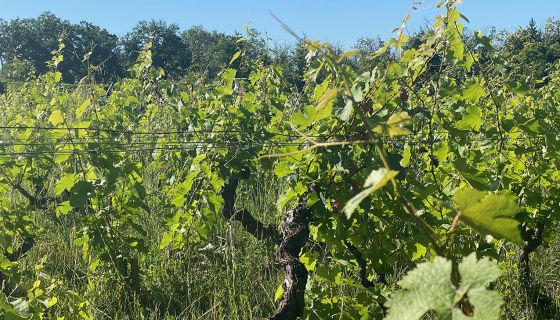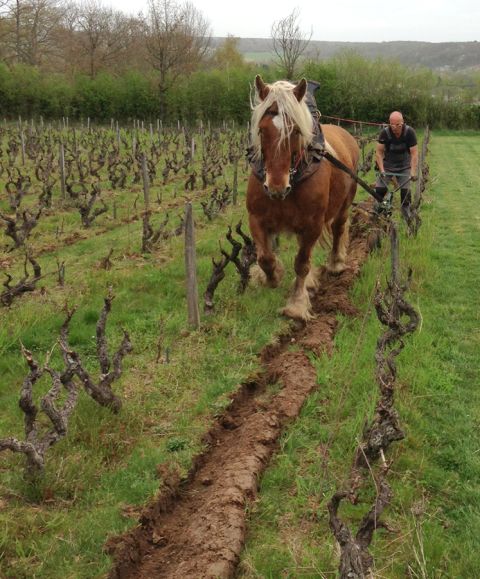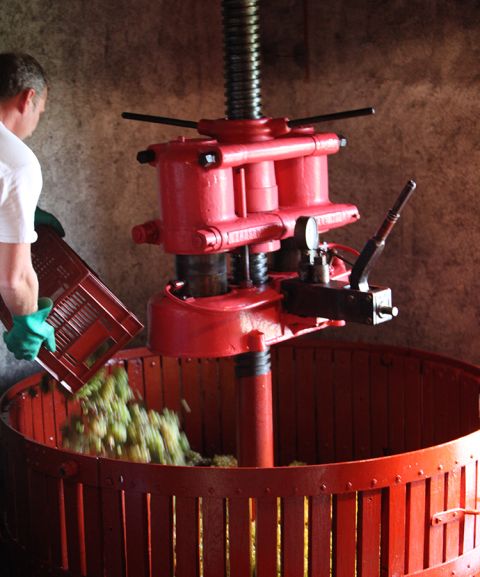Allison Burton-Parker introduces herself: a globe-roaming wine educator and writer living between the Loire Valley, London and Waiheke New Zealand. She is a former luxury advertising executive who was charmed by the Loire – and its wines – a decade ago and never looked back. She holds the WSET Diploma in Wines and is a Loire Valley Master from the Wine Scholar Guild. She is currently writing a guide to Loire Valley wines and is a co-founder of the Loire Wine Academy. Her writing has appeared twice before in the WWC: via a piece on the wine scene in Auckland and a profile of La Grange Tiphaine.
Peter Hahn – Clos de la Meslerie
The regeneration of a vineyard, and of a man.
One typical foggy morning on the banks of the Loire near Vouvray, Peter Hahn is sitting in his chair, enjoying his coffee, gazing out to his vineyards. As the sun rises, the light reveals a glistening, lattice. The morning dew collected on ornate spider webs spanning between the rows of vines, spun magically overnight by a tiny eight-legged army. Peter knew he now had a thriving, happy colony of spiders- visual proof that his efforts to create an agricultural renaissance on his land were paying off. The ecosystem of his vineyards- lost for decades- was not only back, it was thriving and making its own way. The spiders were soon accompanied by menagerie of new animal life: worms, insects, birds, wild hare, deer. One could imagine Peter as a vinuous Snow White- strolling amongst the vines being trailed by a small brigade of happy creatures.
Starting over – in every respect
Peter Hahn was a strategy consultant, living a high-flying, high-stress life in Paris. American by birth, he had spent over two decades globe-hopping, seeing the world via conference rooms and airport lounges and struggling to find enough time for sleep, let alone for himself. He provided his family with more than everything they needed, except time with him. One fateful day his Damascene moment arrived: a calamity of events only a C-suite executive can fully understand led to a panic attack, which forced him to rethink everything. He needed drastic change, much more than a vacation or a sabbatical. He yearned to forge an entirely new, entirely simpler life. He wanted to get his hands dirty, to make something substantial, something real, something besides money. To be in touch with the land, his family, and ultimately with himself. And he decided that becoming a farmer and making wine with regenerative practices was his path.
Peter began hunting for a base for this new chapter, and first visited Clos de La Meslerie in the Loire Valley in 2002. The domaine produced wine for centuries, but had been ignored for decades, leaving a crumbling house and an abandoned chai. And the land, four parcels of Chenin blanc vines, were essentially trapped in fermage - a French sharecropping system that grants farming rights under contract. The existing farmer was doing his best to maximise yields, and as a consequence, doing a great job of destroying the soil and vineyard life with chemical farming. And unfortunately there were another five years on the contract.
Certainly not an ideal situation, but Peter was both determined and smitten, and bought the place anyway. He says, “It was not a ‘trophy' investment… It was a desperate, hail-mary pass towards finding simplicity, stability, and most importantly, meaning”. He left his old life behind, moved his family to the ramshackle domaine in the countryside and never looked back.
A plan to do nothing
Clos de la Meslerie is located in the sleepy village of Vernou sur-Brenne- just East of the relative bustle of Vouvray but still within the bounds of the appellation. There are endless rolling hills of vines, many on gentle slopes leading up from the river. All bathed in a magical golden light that has inspired generations of artists.
The entrance to the domaine is guarded by a lush green forest. Upon entering, he temperature noticeably drops and the noise of tractors is replaced by birdsongs. Just beyond is a modest but gorgeous 17th century chateau surrounded by a clos of four hectares of vines. Technically it is not a true clos - instead of stone walls, the vines are surrounded by trees and hedges.
This kind of enclosure is rare in the area, but the isolation it affords was a big draw for Peter. He knew he wanted to do things his way, whether it was the ‘right’ way or not, and thus liked this privacy, and the close proximity of the house to the vines. He could create his own world, on his terms: for the land, the house and his family.
Upon arrival in 2003, the family began to sort through the remnants of centuries past, each day discovering surprises both delightful and maddening. Slowly they created a liveable space, found schools and markets, and began building their new lives.
Not one to rest idly, Peter enrolled in the nearby viticultural school and began asking question after question to every organic winemaker who would take his call. He walked every inch of the vineyards, studying the soils and aspects and mapping the wildlife. A plan to revive and restore the land began to brew, culminating in an aggressive mission: do almost nothing. He wanted to “leave behind the warped ideas of modern agriculture,” and interfere as little as possible.
The Renaissance
When Peter was finally able to take over the land, he stripped back every part of the growing process. From soil management to pesticides to compost, the singular goal was to let the land regenerate through organic and biodynamic practices.
He became conscious of the centimetres of vital life taken away with every intervention and pass of his tractor. He dramatically reduced copper, created homeopathic sprays, plowed less and let nature decide what to grow between the rows.
He sought out alternatives to every kind of machinery required, and joined a small collective of winemakers who banded together to support the dying art of traction animale- using horses in the vineyard. The process is not only less intrusive, it increases soil quality dramatically. Peter admits, “It is expensive and time consuming, but the benefits are there after every passage." Though he admits to one downside: he now cringes at the sound of his own tractor when it’s required.
At the same time, he saw his own life and spirit start anew as well. He discovered the joy of repetitive manual labor, of long days of work and well-earned hearty meals. He forgot about endless deadlines and all-nighters and fully embraced being responsible for an ecosystem… being a winegrower.
Peter prefers to call himself a winegrower, not a winemaker, as he firmly believes, “…wine is made in the vineyard, and what happens in the cellar is ancillary at most and irrelevant at best. Everything is in the grapes. I am, first and foremost, a grape-farmer.”
He thought the initial vineyard renaissance would take a decade, but quickly saw substantial changes in the soil. Day after day in the vines he noted improvements, and in just three years the transformation was astounding. The enclosure of the domaine proved to be a boon for corralling the various lifeforms vital to the ecosystem, and separated his vines from contamination by nearby parcels that were farmed more chemically. Within this sacred space he also embraced a full organic lifestyle for the family: planting orchards, raising bees, foraging mushrooms, keeping chickens and making his own daily bread.
Everything by hand
In those early months following the purchase, Peter began literally digging through piles of debris in the house, the basement, the chai. One day he discovered the remnants of a very old hydraulic basket press. Inquiries with several locals on how to reassemble it yielded nothing but shrugs. It seemed that the 1928 press was a relic of a time too far gone by. Finally the father of a fellow winemaker who had worked with a similar press decades ago came to the rescue. After a voracious group effort and a great deal of the kind of ingenuity that only comes from desperation, the press was reassembled. It was cautiously tested, and that first juice was a milestone for Peter. Not just for the resurrection of this old, forgotten press, but also for this old, forgotten way of making wine. Gentle, slow, minimal, purposeful. Mirroring exactly what he was doing in the vineyard. And increasingly in his life.
There is very little modern equipment at Clos de La Meslerie full-stop. From blister-inducing hand cutters to hand-cranking pumps, each decision for action among the vines or on the cellar is made with the lightest touch possible. Almost all work is done manually, mostly by Peter, with help along the way from his wife Juliette and a small but loyal band of saisonnieres and friends.
He uses herbs and grasses from the land to make tinctures and the requisite biodynamic formulations. The sustainability practices extend to every aspect of the domaine- water usage, bottling, shipping. Even the corks used come from a sustainable forest in Portugal, and are printed with water-based inks.
His vines are up to 80 years old, which combined with many missing vines in every plot, means yields hover around a shockingly low 20hl per hectare. Despite the advice of fellow winemakers to grub up half of them and replant for higher yields, Peter again favoured regeneration and embarked on an extensive program of marcottage- an ancient technique of vine layering where a cane of an existing vine is trained downward and buried. It produces buds, which in turn sprout roots, and eventually the connecting cane is cut and the new vine grows independently. This avoids adding any new materials into the microsystem, keeping the patrmimoine genetique. It is risky (less disease resistance), time-consuming and labor-intensive. In other words, perfect for Peter.
At harvest time, there are no measuring tools or lab analyses, Peter just passes through the vines, tasting grapes repeatedly, letting them mature per the whims of nature. If bad weather threatens or there's a risk of rot, he advances his hand-harvesting plan. Otherwise he picks in a series of tries (passages), selecting only the ripest grapes each time. Whole bunches are hand-pressed for a slow, gentle extraction, then the juice is gravity fed into an underground cellar where it slumbers for a year in old oak barrels. There is no fining or filtration, the only addition is minimal sulphur for stabilsation.
Each trie is vinified and aged separately, so the recipe for the blend is different every year. Peter refuses to standardise his wine to specific sugar levels and aims to capture, “the spirit of a Vouvray Chenin in a single cuvée.” This means the sweetness of each vintage varies- a detail not popular with merchants who seek the consistency of the traditional sec and demi-sec classifications. But Peter insists on being as hands-off as possible, and making use of every drop pressed. This has led to experiments making a sparkling Chenin in cooler vintages, but his focus and goal every year is to simply make one cuvée that is the purest expression of his vines possible.
Is sustainable winemaking actually sustainable?
So if regenerative winemaking is so good for the soil, the grapes, the quality of wine, the planet… one must ask why it isn’t more widespread? Peter admits, “There are consequences to this type of winegrowing. Lower yields and higher costs translate into more expensive wine. Responsibly made wines are unfortunately mostly consumed by a certain social class.”
Clos de la Meslerie retails around €25, which is three to four times the average price of most Vouvray. A few years back, while lunching in a local restaurant, a fellow dinner scoffed at the price of a Peter’s wine, exclaiming it to be absurdly expensive and refusing to order it. This despite the fact this man had a cellar filled with Grand Cru Burgundy.
This is where the misalignment of the market dynamics comes into focus. Consumers seem happy to pony up for a big names and lauded vintages, but balk when it comes to paying a bit more than usual for responsibly made wines. The market just isn’t (yet) supporting enough careful, considered, organic and/or biodynamic winemaking. This has to change.
Peter acknowledges that his type of winegrowing is great for making wine and horrible for making money. Every year brings a roller coaster of potential profitability: In the best years, his production reaches nearly 10,000 bottles, but in 2021, catastrophic spring frosts cut that to around 1500. He counts himself fortunate that he sells all his wine every year, and can make decisions per what is best for the land and not only the bottom line. But he realises a more profit-focused proprietor would have to make substantial changes, likely undoing much of his hard work. Though he mentors young winegrowers and waxes lyrical about the benefits of regenerative farming, he knows it is difficult to implement on a larger scale. At least not until consumers makes their preferences heard with their wallets.
Enjoying the spoils
Sitting in the garden outside the chateau, Peter recounts his transformation and I contemplate both the simplicity and complexity of his ethos. A tiny spider descends on a thread from the table, happily bobbing up and down in the sun. As if the spider knows there is no chance a nearby human would attempt to disrupt its work in any way. Any usual arachnophobic tendencies disappear and I suddenly feel like a lucky audience to this ecosystem in action. A thankful intruder in this regenerated land, enjoying the fruit of its labour- and a glass of unforgettable Chenin.
The main image is entitled 'The ecosystem between the vines', credit Allison Burton-Parker.
















